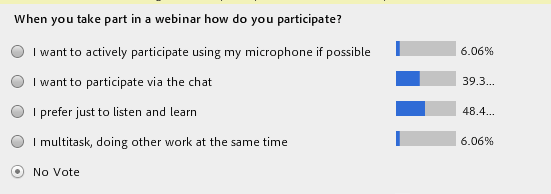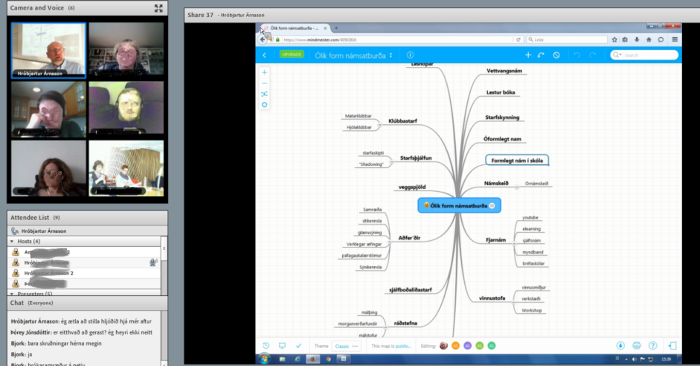
There are many reasons to organize your webinar in such a way that participants can (or must) collaborate with you and / or each other during the event.
It seems quite evident that many participants will intuitively choose to participate little and if they do so they will opt for the method demanding the least commitment possible, or a way that does not call special attention to them such as using the microphone and or camera.
This is something we have repeatedly experienced in our webinars and something participants have told us through online real-time surveys before or during webinars:

A webinar can be seen as a “low-commitment” event, during which participants can choose to “lurk” and / or multi-task and thus choose not to participate actively. This is understandable and it is probably wise to consider that this choice is also quite ok. Maybe the ways in which people participate in your events can be different, and one should definitely consider which ways of participation are OK and in view of that organize the event in such a way that people can participate in different ways and also gain something from rather passive participation.
HOWEVER, although many seem to choose a “low-commitment” approach to online participation, there are many good reasons to find ways to encourage participation.
In general, we can state that:
- More attention and engagement, leads to more enjoyment and learning
- More activity in a webinar leads to greater engagement and thus more interesting discussions
- Someone who is actively participating in a learning event is more likely to work with the ideas presented, connecting them to his or her own situation and finding ways to use the ideas presented in practice
- When people participate in learning activities, they share reactions, interpretations and ideas for application of the ideas presented, this helps other participants understand and apply the ideas for themselves. It is quite impossible to imagine a presenter coming up with all the useful interpretations, connotations and examples which could be useful for all the audience. Thus increasing interaction during a webinar can increase its quality.
When people are able to observe other people learning, they tend to learn with them
An important reason therefore, to enable participation and interaction among the participants, is that there is a greater possibility of them learning more and enjoying the event. An event with various forms of interaction is more captivating, interesting and more fun than a monotonous event, so by eliciting participation from webinar guests you are creating a space where people meet and learn in a deeper way than they expected and thus increasing its quality for most if not all participants. By helping webinar participants to meet each other and you, in meaningful ways, you are opening possibilities for significant learning.

Webinars offer many ways and channels for interaction. Online conferencing software solutions usually incorporate a variety of tools to enable interaction: Voice, video, text chat, common notepads, whiteboards and screen sharing are the most common. Some also include polling apps and “break-out spaces” where participants can be divided into small groups for more intimate discussions.
The most straightforward ways to enable participants to interact during the event is through text chat, where they can write questions, comments and answers. Participants can use the microphones to ask or answer questions. Likewise, they can turn on their webcams and be visible to others on the screen thus increasing the feeling of inclusion and allowing for some “body-language”.
The idea here is to gradually draw the participants in so that when they are ready they have gained the confidence to ask questions, respond or state their view personally in front of the other participants. This is in sync with the ideas between our model of Webigagement.
In this toolkit we have listed up a number of services which enable discussions and collaboration and are included in most online conferencing services. Moreover we also introduce some other online services which can be used alongside them with good results:
Communication and collaboration increase the benefits for webinar participants:
- Collaborative tools “Plain vanilla” On the collaborative tools built into most web conferencing systems
- Collaboration on documents Learn how to get participants to write together
- Collaboration on canvases Use canvases to offer totally unstructured or very structured collaboration
- Collaborative mind mapping Mindmaps can help participants structure their discussions on the run and give them a better overview of their ideas